 |
||
|
||
| ||
On the 31 of August, 1999 the world started to change when the NVIDIA company has announced GeForce 256. From that time all the developments have been aimed at 3D graphics to be more realistic. The developers do not think whether to provide with some particular hardware support, they just do it. So, GeForce 256 has performed its mission. But today it's not only NVIDIA that contributes to the progress, it's also ATI. Soon we'll witness new products with HW T&L support from Matrox and 3dfx. The latest 3D accelerators support a lot of interesting useful functions, which allow to increase an image quality. And there is one more fact to stress. The Voodoo5 5500 card from 3dfx with 2 graphics processors shows the performance on the level of a card with only one graphics core - GeForce 256 from NVIDIA with DDR SGRAM. Today, multichip solutions do not seem so profitable and winning in the speed aspect. Besides, almost all modern 3D graphic solutions are based on polygon or so-called traditional rendering architecture. But the company that has been developing for a long time graphics processors based on tile (or non-traditional) rendering architecture is Imagination Technologies Ltd (earlier known as VideoLogic). Its PowerVR Technologies department deals with graphics processors. Last year the STMicroelectronics became a partner of Imagination in silicon engineering and chip production (earlier it was known as SGS Thomson). STMicroelectronics is a giant in semiconductors' production with its own plants and powerful engineering labs. Some time ago STM was a partner of NVIDIA at creation and production of chips of NV1 an Riva128 series. So, the cooperative labour of PowerVR Technologies and STMicroelectronics has led to a new product KYRO which belongs to the new series of graphics processors with tile architecture - PowerVR Series3 (PVRS3). As you might know, the first version of accelerators of Power VR series was quite successful in the market (i.e. m3D accelerator from Matrox). Then after a while it released NEON-250 (a new accelerator of Power VR Series 2), but it wasn't the best one, as at that time there were inexpensive accelerators with the higher performance. In result, the Neon 250 based cards were only on the British market. Well, now let's pass over to the features of KYRO architecture. Tile architectureAs you know, in the traditional 3D rendering architecture all operations are carried out upon polygons, which build the scene. The polygons' assortment is implemented on the base of the information from a Z-buffer. These data, depending on the reading way, can form either Z-buffer or W-buffer. The difference is in the sorting way. The performance might increase, if the polygons are executed beginning from the near to the far. The Z-buffer requires some memory. But it causes extra expenditures. There are 2 solutions: you can apply different modified algorithms or use a non-traditional rendering architecture (i.e. a tile one). One of the advantages of the tile architecture is that it's unnecessary to use a Z-buffer. The Z-buffer in tile accelerators is integrated in a chip. This helps to economize the memory; then the performance increases at the expense of absence of additional reading/writing cycles in the memory. The tile architecture works the following way: the whole scene is divided in small parts called tiles (i.e. 16x32 pixels). Each tile is operated separately. For it, there are the following basic tools:
Frame Buffer Tile is a separate space in the chip (alike an integrated memory), which is intended for sorting of polygons, pixels processing etc. All these processes are executed in the chip at 32-bit color mode and at the full core frequency. For example, at the clock frequency of 125 MHz the tile processor can handle about 20 million triangles per second. Deferred Texturing deals with final pixels (those which will be displayed). And there is no need in unnecessary texture memory access. Next. Since the blending operations is made in the chip with 32-bit accuracy, the color rendition is very high. The scaling is very easy for the tile processors: the performance increases proportionally the number of the tiles. Now let's turn to the chip itself. KYRO basic characteristics3D part includes the following hardware possibilities:
128 bit GUI acceleration (2D-part) includes:
The interface part supports:
"Stream" video and MPEG2 decoding support:
128 bit memory interface supports:
The integrated 270 MHz palette DAC contains:
The boardNow let's look on the card: The card has AGP2x/4x interface, 64 MBytes SDRAM located in 8 chips on the right side of the PCB: 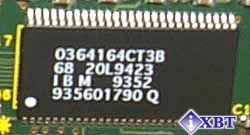 The memory chips are produced be IBM, they are characterized by the 6.8 ns access time, 143 MHz working frequency. As for KYRO working frequency, we might suppose, that the chip works at 115 or 125 MHz. The board has an active cooler, which you might see only on some Canopus Spectra cards. This small quality fan moves the air volume along the videocard. 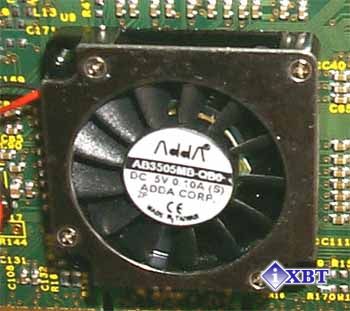 The board is green with yellow writings. The PCB has a jack for digital displays and the relative control chip. OverclockingAt the present moment there are no any utilities for an overclocking on the KYRO, that's why the card was working at the regular frequencies. Installation and driversNow we'll dive into the practical part. The testbed is following:
For testing we used 4.44 drivers' version. Setup the drivers and you will see the following: 2D-parameters adjustment: 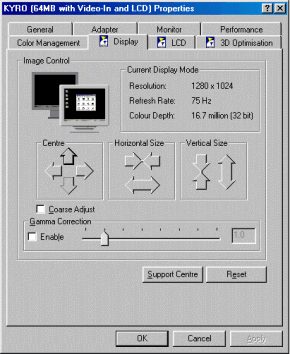 image output on the LCD (doubling): 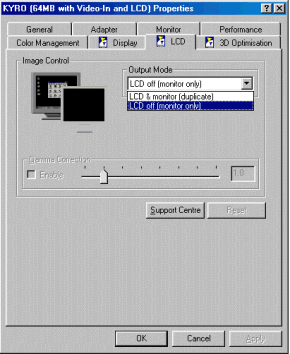 Direct3D-parameters setting: 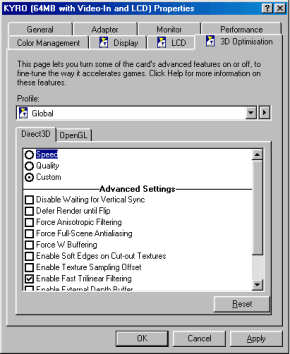  OpenGL-parameters setting: 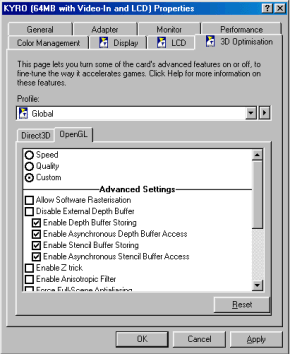 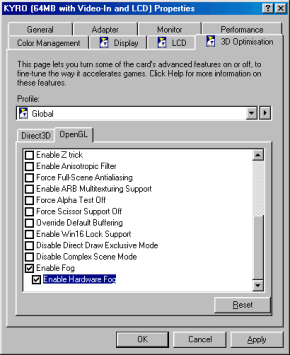 As you can see, the settings allow to adjust main 3D-functions: filtering, switching-out of Vsync, Z and W-buffers control, EMBM relief texturing etc. The drivers include ICD OpenGL, but, unfortunately, they don't support API PowerSGL (that's why the game Unreal failed to set up through this interface). No means for overclocking are available here. The test resultsI would notice with pleasure, that the KYRO based card from STMicroelectronics has all 2D marks on a quite high level. Let's check the speed of KYRO in 3D-graphics with 3 games:
These tools are quite enough to show the videocard performance when working through 3 main API. For comparison we give you the diagrams of 2 more videocards: ELSA ErazorX (based on NVIDIA GeForce 256 SDR) and reference card NVIDIA GeForce2 MX. 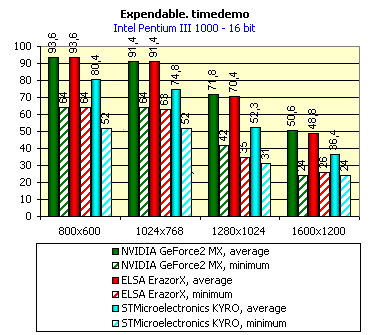  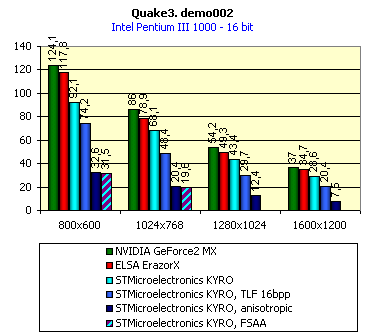 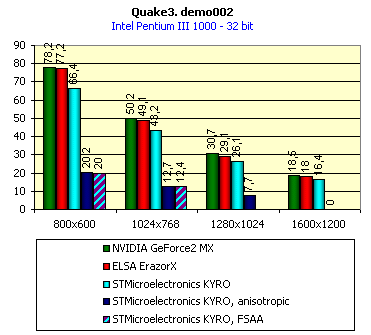 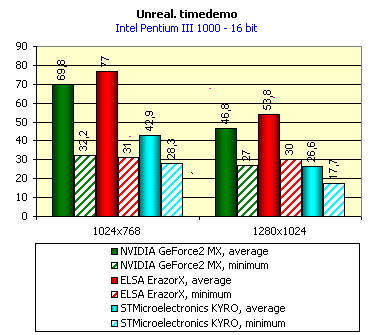 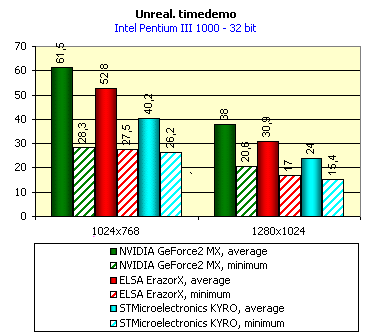 As you see, the KYRO based card falls behind here in the all tests but for Expendable in 32-bit color mode. The conclusion is that with such poor drivers KYRO based cards couldn't compete with those based on NVIDIA GeForce2 MX. EMBM support doesn't help the performance increase, because the most of the games with EMBM support work only with G400 based cards from Matrox. First it may seem that the tile architecture hasn't proved to be the best. But it has! Look: KYRO has only 2 rendering pipelines with 1 texturing module on each, and GeForce 256, for example, has 4 pipelines with one textured block on each. And the performance of the both cards doesn't differ. Note, that "High Quality" was switched on when in Quake3 in 32-bit color mode (which ensure the trilinear filtration). In 16-bit color I also specially set the trilinear filtration to show you that the performance difference between 16-bit color and 32-bit color is nearly zero. Although, the general speed decrease when using the trilinear filtration on the KYRO based card is horrible. And this is not surprising, since KYRO has only 2 pixel pipelines and 2 texturing modules. This means that multitexturing and trilinear filtration can't work simultaneously at the high speed. It's similar to the performance decrease with anisotropic filtration in use. Then, the speed when in the FSAA mode (Anti-aliasing) is awfully low. In general, today NVIDIA GeForce2 MX can easily beat KYRO. Though, we are not sure what the price is, and whether the drivers will be improved. If they are, this chip might be promising. Besides, there are complains about graphic image deformations in some games. As for the anisotropic filtration, you can see yourself how high the quality is: 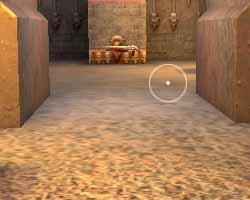 trilinear filtration 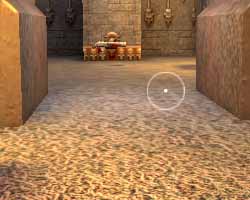 anisotropic filtration The image quality of the second screenshot is much higher. But the performance in this case is 3 times lower! Note, that KYRO has a real trilinear filtration as compared with an approximated one of NVIDIA Riva TNT/TNT2 and 3dfx Voodoo3/4/5 (in OpenGL/Glide). When playing DVD-Video with WinDVD 2.1 programmed player the CPU load is not more than 25%, though there are some small artifacts. ConclusionWell, the KYRO based card (PowerVRS3) from STMicroelectronics/Imagination has crashed nearly in all speed tests when competing with the NVIDIA GeForce2 MX and GeForce 256 SDR based cards. Undoubtedly, KYRO has shown all advantages of a tile architecture (if not take in not account the performance in the games). But in general, users would hesitate whether it's worth to buy. Only if the price is not more than $100 and the drivers are improved, it will have a chance of success in the market. Some manufacturers (VideoLogic, Innovision) have announced KYRO based card. Besides, there is some probability that some cards will be based on a new version of KYRO, what might increase the performance. Highs:
Lows:
Write a comment below. No registration needed!
|
|
Platform · Video · Multimedia · Mobile · Other || About us & Privacy policy · Twitter · Facebook
Copyright © Byrds Research & Publishing, Ltd., 1997–2011. All rights reserved.